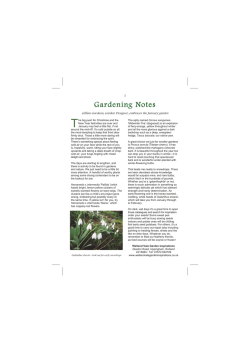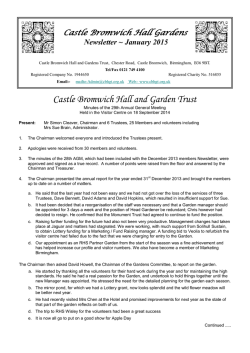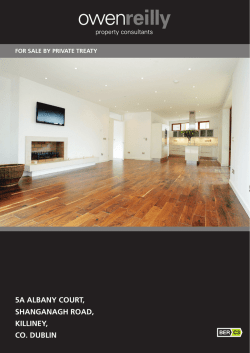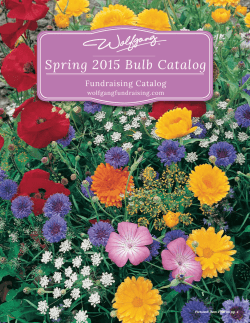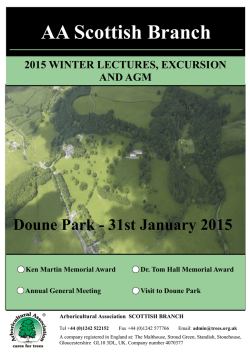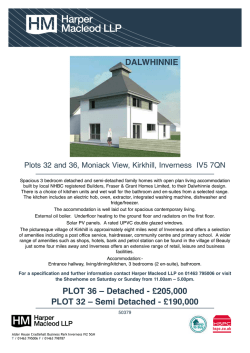
Urban Agriculture Initiative - Zoning Ordinance
Sect. 3 first Urban Agriculture Zoning Ordinance Recommendations to Enhance Urban Food Systems Prepared by the City of Knoxville’s Office of Sustainability February 2015 Urban Agriculture Table of Contents Table of Contents Acknowledgments ..................................................................................................................................... p.1 Section 1: Background 1.1 Intentions……………………………………………………………………………………………………………………………….p.2 1.2 Identifying Need .......................................................................................................................... p.2 1.3 What is Urban Agriculture? ..................................................................................................... p.2-3 1.4 Why is an Ordinance Amendment Needed? .............................................................................. p.3 1.5 Why Regulate Urban Agriculture Through Zoning? ................................................................... p.3 1.6 Who Was Involved in the Development of This Proposal? ........................................................ p.3 1.7 Intentions .................................................................................................................................... p.4 1.8 Areas in Need of Further Research .......................................................................................... p.4-5 Section 2: Descriptions of Proposed Amendments 2.1 Garden, Personal ......................................................................................................................... p.6 2.2 Garden, Community..................................................................................................................... p.6 2.3 Garden, Market............................................................................................................................ p.7 2.4 Apiary ........................................................................................................................................... p.7 2.5 Accessory Structures ................................................................................................................. p.7-8 2.6 Compost, Backyard ...................................................................................................................... p.8 2.7 Supplementary Regulations ......................................................................................................... p.8 2.8 Full Text of Proposed Amendment…………………………………………………………………………………….p.9-14 Section 3: Urban Agriculture Public Comments.................................................................................. p.15-18 Urban Agriculture Acknowledgments City of Knoxville Mayor Madeline Rogero Erin Gill, Director; Office of Sustainability Brian Blackmon, Project Manager; Office of Sustainability Peter Ahrens, Director; Plans Review and Inspections Tom Reynolds, Deputy Director; Plans Review and Inspections Scott Elder, Zoning Coordinator; Plans Review and Inspections Robert Moyers, Chief Codes Enforcement Officer; Codes Enforcement David Massey, Neighborhood Coordinator; Office of Neighborhoods Doug Gordon, Attorney; Law Department Crista Cuccaro, Attorney; Law Department Rick Emmett, Downtown Coordinator; Policy & Redevelopment Anne Wallace, Cumberland Avenue Project Manager, Policy & Redevelopment Knox County Health Department Fiona McAnally, Program Manager; Community Health Policy Katheryne Nix, Health Educator; Food Access Metropolitan Planning Commission Mark Donaldson, Executive Director Liz Albertson, Sector Plans and Environmental Resources UT Extension Neal Denton, Extension Agent & Knox County Director David Vandergriff, Extension Agent Cover Photo Acknowledgments (Clockwise from top left) CAC Beardsley Community Farm El Puente Parkridge Community Garden CAC Green Thumb New Harvest Park Community Garden Knoxville Permaculture Guild Please email [email protected] with any comments. Urban Agriculture Background Section 1: Request The City of Knoxville Office of Sustainability requests that the Metropolitan Planning Commission consider the proposed updates to the zoning ordinance, detailed herein, and make a recommendation to City Council to approve revisions that better allow for “Urban Agriculture.” 1.1 Intentions By proposing these amendments to the City’s zoning code, the City of Knoxville desires to affirm the City’s commitment to the local food production goals outlined in the Bloomberg Philanthropies application of 2013 and the regional goals outlined during the PlanET regional planning process as detailed below: Support the local food economy. These amendments increase the ability for citizens to garden for pleasure or profit, and enable greater entrepreneurial opportunities for urban food production, sales, and job creation. Increase access to healthy, local food for all communities. The City of Knoxville wants to develop zoning code regulations that support its residents’ ability to grow, sell, and buy healthy food. Part of this process is reducing zoning review and permitting requirements for smaller or less intensive agricultural activities. Support healthy, livable neighborhoods by creating opportunities for reuse of vacant or blighted properties. Viewed as an opportunity to both preserve green space and promote food security, accommodating urban agriculture in zoning opens the door to innovative ways for residents to grow their own food while opening the door for a creative reuse of otherwise unused properties. 1.2 Identifying Need The Knoxville and East Tennessee region is known for its rich agricultural history and scenic farmland. Knoxville is home to the nationally distinguished Market Square Farmer’s Market, commissioned the first Food Policy Council in the nation, and serves as an educational hub through the University of Tennessee’s Institute of Agriculture program. The PlanET Health Impact Assessment identified a prevalence of major health issues such as obesity, diabetes, and heart 2 Urban Agriculture Background disease among residents, which are strongly linked to lack of access to healthy, affordable food.1 Through PlanET’s assessment and community input processes, local food production was identified as a regional goal that would not only help grow the local food economy, but would also help address the serious health concerns facing residents.2 A staggering 11.26% of Knoxville’s households are located in food deserts, or areas where there are very few, or no, healthy food options3. That amount is higher than Anderson, Blount, Loudon, and Union counties. In addition, Knoxville is also home to vacant and blighted lots that cost the city in excess of $117,000 to maintain, and countless more dollars in community impacts. In response to the 2013 Bloomberg Philanthropies Mayors Challenge, Mayor Rogero proposed an outside-the-box idea to address blight and strengthen our local food system while emphasizing our local agricultural heritage. This idea, sourced from extensive community input, was to create an “urban food corridor” in Knoxville by creating mechanisms to allow for the expansion of local food production within the city. In addition, the City wishes to support the many residents and groups who wish to grow food on their property and in other areas in the city. The proposed zoning ordinance updates detailed in this document are the foundational recommendations that establish the expected uses and needs of successful urban agriculture in Knoxville. They represent the input of multiple governmental departments and community members alike. 1.3 What is Urban Agriculture? Urban agriculture refers to agricultural practices designed for the urban environment. The idea of urban agriculture in the United States has roots in the war gardens and victory gardens of World Wars I and II. These gardens were critical pieces of public and private infrastructure, and were a way for communities to be more self-sufficient in a time of great need. At their peak, victory gardens rivaled commercial production and accounted for 44% of the fresh vegetables produced in the United States.4 Marketing of victory gardens ended after the end of World War II. During the 1970s, the community garden movement began spreading throughout the U.S. Community gardens are the most common form of urban agriculture in Knoxville, and the Knoxville-Knox 1 Plan East Tennessee Health Impact Assessment 2013. http://www.planeasttn.org/DesktopModules/Bring2mind/DMX/Download.aspx?EntryId=1271&Command=Core_D ownload&PortalId=0&TabId=143 (p. 29-30) 2 “Plan East Tennessee Playbook,” http://www.planeasttn.org/GrowStronger/RegionalPlaybook.aspx (pp. 24-28). 3 “Plan East Tennessee Equity Profile,” http://www.planeasttn.org/Learn/RegionalAssessments.aspx, (March 2014). 4 Bassett, Thomas J. “Reaping on the Margins: A Century of Community Gardening in America.” Landscape, 1981 v25 n2. 1-8. 3 Urban Agriculture Background County Community Action Committee has worked with community groups to develop and maintain community gardens since 1978. Recently, following national trends, local interest has grown in more profit-driven urban agricultural endeavors. These market gardens, or urban farms, present economic opportunities such as job creation and increased local revenue as well as opportunities to alleviate urban blight while providing fresh local produce. 1.4 Why is an ordinance amendment needed? Knoxville’s zoning code has not kept pace with changes in the local food economy. The current code can be unclear in defining which urban agriculture practices are allowed, and in some cases, is unnecessarily restrictive. The proposed amendments will remove potential barriers to food production on private property. These amendments will also allow for additional, productive uses of otherwise unused or vacant properties. By removing these barriers, the City of Knoxville and community partners can better develop programs that increase access to healthy, local food. 1.5 Why regulate urban agriculture through zoning? These proposed changes in zoning regulations are designed to better accommodate urban agriculture best practices while protecting the environment and the community. During public information gathering conducted by the City, there were concerns raised about regulation and enforcement of poorly maintained or abandoned gardens. Inevitably, the addition of urban agriculture in communities will change the visible landscape; however, there are aesthetic and safety standards that can and will be enforced to preserve the overall integrity of neighborhoods. These additions to the zoning ordinance are meant to establish a stronger legal foundation for the use of urban agricultural practices and to subsequently foster healthier neighborhoods by increasing access to healthy food sources. While the City of Knoxville wants to promote the development of gardens and agricultural entrepreneurship, we also recognize the need to mitigate potential negative impacts of on-site sales, larger scale gardens, and other aspects of urban agriculture. 1.6 Who was involved in the development of this proposal? The Office of Sustainability worked with a team comprised of the City’s Law Department, Plans Review & Inspections, Neighborhood Codes Enforcement, the Office of Neighborhoods, KnoxvilleKnox County Metropolitan Planning Commission, the Knox County Health Department, and University of Tennessee Extension. Community comment was sought through a public meeting on July 14, 2014. The summary of that meeting and comments are included in Section 3 of this document for reference. 4 Urban Agriculture Background 1.7 Areas in need of further research The public input process helped identify community concerns about issues ranging from potential barriers for successful gardens to potential negative impacts to neighborhoods. The Office of Sustainability recognizes that there are many variables that affect access to healthy, affordable food. The Urban Agriculture Initiative has been broken down into three phases based on topic and effectiveness. The recommendations outlined in this document address Phase 1 of the City’s Urban Agriculture Initiative. The Office of Sustainability intends to address topics related to Phases 2 and 3 in 2015. Phase 1 General Framework. Phase 1, as outlined in this document, establishes the general framework for accommodating urban agriculture in the zoning ordinance. The language reflected in these amendments is based on best practices as implemented by peer cities and by recognized municipal leaders in urban agriculture. Phase 2 Phase 2 focuses on food distribution and livestock. These are two areas of need identified by community members and peer cities for creating more self-sufficient local food systems. Food distribution. Food production is only a small portion of agriculture. Distribution is a key component of the food system, and there are various obstacles to get food to markets within the City of Knoxville. Approaches to address these barriers include establishing food distribution sites for community supported agriculture (CSA) farms, creating more opportunities for farmer’s markets, and developing tools for farmers, both experienced and new, to increase our local food availability. Livestock. The City of Knoxville currently provides a process to keep hens for egg production, but residents have asked for additional research into the keeping of ducks and goats. The current hen ordinance is not without its limitations; for example, the ordinance allows for only six (6) hens whereas the minimum amount of chicks required for participation in the 4-H Poultry Project is 15. The Office of Sustainability will continue to research best practices from peer cities to evaluate the best approach for the keeping of livestock in city limits. Phase 3 Phase 3 is focused on creating a mechanism to turn City-owned vacant and blighted properties into gardens and community assets. 5 Urban Agriculture Background Gardening on city-owned property. Community gardens are permitted in OS-1 and OS-2 (open space) districts, but this document proposes the expansion of community gardens as a permitted use in all zones. The City of Knoxville is currently researching best practices to allow forms of urban agriculture on city-owned properties that are not zoned as open space. This also includes exploring options for land transfers and sales to private parties. Section 2: Descriptions of the Proposed Amendments The aforementioned goal of these updates is to clarify the language related to urban agriculture and to promote its use in the City of Knoxville. The proposed changes add definitions to expand urban agriculture uses on private property. Below are more detailed descriptions of the most significant proposed amendments. 2.1 Garden, Personal Proposed Definition: An area of land on which food or non-food crops are grown by the property owner or other person with an interest in the property for personal or family consumption and enjoyment. Personal gardens may be principal or accessory use. On-site sales are permitted through the use of a temporary use permit issued for a seasonal produce stand. Regulations: Personal gardens are grown on the lot of the property owner or other person with an interest in the property (e.g. a renter or guest). Personal gardens are the most common form of gardening. Currently, personal gardens are considered a landscaping feature and allowed in the useable open space of a lot. Gardeners have had questions about acceptable features, uses, and permitting required for their home gardens. Supplementary regulations are proposed to clarify acceptable structures, permitting requirements, setbacks, and performance standards for gardeners. 2.2 Garden, Community Proposed Definition: An area of land managed and maintained by a nonprofit or group of individuals to grow and harvest food or non-food crops for personal or group use, consumption, or donations. Community gardens may be principal or accessory uses. Regulations: A community garden represents the gardening Community Action Committee GreenThumb interests of multiple non-family members. This allows for garden clubs, non-profits, or other community organizations to establish gardens for their membership. A community garden is space shared by multiple individuals or groups of individuals 6 Urban Agriculture Background for personal enjoyment or consumption. They are community features, not businesses. For that reason, onsite sales are prohibited for community gardens. Groups, businesses, or individuals who are seeking to engage in sales are encouraged to start a market garden. Donation of community garden produce is permitted. Community gardens are currently allowed uses in open space (OS-1 and OS-2) districts; proposed changes would allow community gardens as a permitted use in all base zones. The Office of Sustainability will launch a voluntary community garden registration that will provide interested community members with a resource for finding a place to garden in or near their neighborhood. 2.3 Garden, Market Proposed Definition: An area of land managed and maintained by an individual, group, or business to grow and harvest food and non-food crops to be sold for profit on-site, off-site, or both. Market gardens may be principal or accessory uses. Regulations: Market Gardens focus on sales. Their consumers may be individuals, restaurants, stores, or aggregators. Because of the potential impact on neighborhoods of the for-profit production and sale of crops, Market Gardens are subject to use on review for residential zones. The use on review approval by the Metropolitan Planning Commission (MPC) allows for consideration of a proposed project’s impacts in a specific location and ensures that the use on review complies with standards set forth in the zoning code. 2.4 Apiary Proposed definition: A collection of one (1) or more colonies of bees in beehives at a location. Regulations: Bees are integral to pollination, plant health, and vegetable and fruit production industries. The right to keep bees is protected by the Tennessee State Apiary Act of 1995. While bees pose little risk to the general population, the Office of Sustainability is sensitive to those with bee allergies and the dangers of general proximity to beehives. In crafting the language about apiaries within the City, the Office of Sustainability referred to best practices from cities that had addressed urban beekeeping in zoning ordinances and consulted with the University of Tennessee extension agents. 2.5 Accessory Structures Regulations: Accessory structures defined in the proposed amendments include: cold frames, greenhouses, high tunnels, 7 Example of high tunnels Urban Agriculture Background low tunnels, and seasonal produce stands. These definitions were added to provide clarification of acceptable uses and structures related to urban agriculture, and to establish standards for their use. When applicable, language from the United States Department of Agriculture was used to craft definitions that would ensure proposed structures meet the standards of the Environmental Quality Incentives Program (EQIP). All accessory structures are subject to standard permitting procedures to construct, enlarge, alter, repair, demolish, or change the use of a building, Building permit fee schedules and FAQs can be found at the City of Knoxville’s Plans Review and Building website5. The application process is detailed in the Department’s Permits and Inspections Guide.6 2.6 Compost, Backyard Proposed Definition: The composting of organic solid waste, such as grass, clippings, leaves, or food waste (excluding meat and dairy), generated on-site by a property owner or authorized tenant, where composting occurs at the site of origin and the resulting product is for on-site use only. Regulations: Backyard composting will be allowed with certain regulations to mitigate the negative impacts such as smell and attracting rodents. While we did hear from some community members who were interested in small-scale composting businesses, there are TDEC regulations affecting the development of composting facilities that collect and process waste generated off-site. Parties interested in starting a compost collection business are encouraged to refer to Chapter 1200-1-7.11 of the TDEC Rules.7 2.7 Supplementary Regulations The City of Knoxville Neighborhood Codes Enforcement will still be the primary investigator regarding dirty or overgrown lots. In the case of activities related to urban agriculture, enforcement officers determine violations in gardens based on the accumulation of debris and the height of underbrush and grass. The correction process for dirty or overgrown lots is detailed on the City of Knoxville Neighborhood Codes Enforcement website.8 To establish performance standards, we recommend the amendments to the Zoning Code at Article V, Section 4 (Supplementary Regulations) for many uses and new structures introduced. These regulations are crafted to maximize safety and enjoyment of all residents, and include performance standards to guide neighborhood codes enforcement officers to make informed decisions when responding to nuisance complaints. 5 http://www.cityofknoxville.org/plansreview/ http://www.cityofknoxville.org/plansreview/guide.pdf 7 http://www.state.tn.us/sos/rules/1200/1200-01/1200-01-07.pdf 8 www.cityofknoxville.org/publicservice/codes/dirtylots.asp 6 8 Urban Agriculture Proposed Amendments 2.8 Full Text of Proposed Amendments The subsequent tables outline the proposed amendments to Appendix B of the City of Knoxville’s Code of Ordinances in full detail. The items are sorted into their respective sections. The tables below are sorted into the sections that will be amended, and include the suggested action for each item. Article II - Definitions Action Add Item Urban Agriculture Proposed Definition An umbrella term that describes a range of food and non-food growing practices implemented in an urban or suburban setting. Urban agriculture may also include, but is not limited to, beekeeping, aquaponics, hydroponics, backyard composting, hen keeping, and seasonal produce stands. Add Garden, Personal An area of land in which food or non-food crops are grown by the property owner or other person with an interest in the property for personal or family consumption and enjoyment. Personal gardens may be principal or accessory uses. On-site sales are permitted through the use of a temporary use permit issued for a seasonal produce stand. Revise Garden, Community An area of land managed and maintained by a nonprofit or group of individuals to grow and harvest food or non-food crops for personal or group use, consumption, or donation. On-site sales are prohibited for community gardens. Community gardens may be principal or accessory uses. Add Garden, Market An area of land managed and maintained by an individual, group, or business to grow and harvest food or non-food crops to be sold for profit on-site, off-site, or both. Market gardens may be principal or accessory uses. Add Apiary A collection of one (1) or more colonies of bees in beehives at a location. 9 Urban Agriculture Proposed Amendments Add Aquaponics The cultivation of fish and plants together in a constructed, re-circulating system utilizing fish culture to increase nutrient concentrations of irrigation water for the purpose of producing food or ornamental plant crops. Add Cold Frame Add Composting, backyard Revise Greenhouse Add High Tunnel Add Hive or Beehive Add Hydroponics Add Low Tunnel Add Seasonal Produce Stand A four sided enclosure with a transparent or translucent and removable or adjustable roof, built low to the ground to house and protect food or nonfood crops outside the typical growing season. The composting of organic solid waste, such as grass, clippings, leaves, or food waste (excluding meat and dairy), generated on-site by a property owner or authorized tenant, where composting occurs at the site of origin and the resulting product is for on-site use only. A type of freestanding covered structure that has a supported framework and covered with a translucent material such as plastic or glass. A greenhouse may use generated or electrical heat or power and its purpose is to house and protect food or non-food crops during all seasons of the year. A type of freestanding, covered structure that has a supported framework, typically made with metal piping and covered with a translucent material such as plastic or glass. Crops can be grown either in the natural soil profile or by installing permanent beds. A high tunnel does not have heat or electrical power and its purpose is to house and protect food or nonfood crops outside the typical growing season. Also referred to as hoop houses. A container or structure used by a beekeeper to provide a cavity in which a colony of bees is expected to establish a permanent nest. The propagation of plants using a mechanical system designed to circulate a solution of minerals in water and without soil. A temporary, freestanding structure that has a supported framework, typically made with hooped PVC pipe or wire and covered with plastic. A low tunnel does not have heat or electrical power and its purpose is to house and protect food or non-food crops outside the typical growing season. A temporary sales space of portable or sectional 10 Urban Agriculture Proposed Amendments construction and no more than 100 square feet, which is used to sell produce grown on-site. Article IV – Specific District Regulations Amendments Action Add Section(s) 2.1.1 – 2.1.8 Item B. Permitted principal and accessory uses and structures. C. Uses and structures permitted on review B. Uses permitted 2.3.1 – 2.3.3 Zones Affected R-1, R-1A, R-1E, EN-1, EN-2, R-1HK, R-2, R-3, R-4 R-1, R-1A, R-1E, EN-1, EN-2, R-1HK, R-2, R-3, R-4 O-1, O-2, O-3, C-1, C-2, C-3, C-4, C-5, C-6, C-7 I-2, I-3, I-4 Add 2.1.1 – 2.1.8 Add 2.2.1 – 2.2.10 Add Add 2.4.4 F-1 B. Permitted Uses Add 3.1 RP-1, RP-2, RP-3 Add 3.1 RP-1, RP-2, RP-3 Add 3.2 SC-1 B. Permitted Principal and accessory use structures C. Uses and structures permitted on review B. Uses permitted Add 3.4, 3.4, 3.9 PC-1, PC-2, I-1 B. Permitted uses Add 3.10 BP-1 C. Uses permitted B. Uses Permitted 11 Proposed amendments(s) Personal Garden, Community Garden, Urban Agriculture Market Garden Personal Garden, Community Garden, Market Garden, Urban Agriculture Personal Garden, Community Garden, Market Garden, Urban Agriculture Personal Garden, Community Garden, Urban Agriculture, Market Garden Personal Garden, Community Garden, Urban Agriculture Market Garden Personal Garden, Community Garden, Urban Agriculture, Market Garden Personal Garden, Community Garden, Urban Agriculture, Market Garden Personal Garden, Community Garden, Urban Agriculture Urban Agriculture Proposed Amendments Add 3.10 BP-1 Add 3.11 TND-1 Add 3.12 TC-1 Add to 4.2.5 All CU Add to 4.2.5 All CU Add to 4.2.5 All CU Amend 4.1.4 All SW C. Uses permitted (10) c. B. Permitted principal and accessory uses and structures C. Uses permitted (Core Area Ground and Peripheral) D. Allowed Use Table (Commercial Uses) D. Allowed Use Table (Residential Uses) D. Allowed Use Table (Public Uses) C. Major Agriculture Market Garden Personal Garden, Community Garden, Urban Agriculture, Market Garden Personal Garden, Community Garden, Urban Agriculture, Market Garden Market Garden Personal Gardens Community Gardens Major agriculture includes animal raising including horses, hogs, cows, sheep, goats, and swine, poultry, apiculture, aquaculture, dairying, personal or commercial animal breeding and development; floriculture, horticulture, pasturage, row and field crops, viticulture, tree or sod farm, silviculture; animal boarding, outdoor; livestock auction; milk processing plant; packing house for fruits or vegetables; plant nursery; plant nursery with landscape supply; retail or wholesale sales of agriculturally-related supplies and equipment; stable; or any similar use. Major Agriculture does not include Urban Agriculture (Personal Gardens, Community Gardens, or Market Gardens). Article V – Supplementary Regulations Section 4 – Accessory uses, buildings and structures 12 Urban Agriculture Proposed Amendments Action Add Item B. Permitted accessory structures Proposed amendment(s) 9. For Community Gardens, Personal Gardens, and Market Gardens a. High tunnels b. Greenhouses c. Cold frames d. Low tunnels e. Storage shed or utility building f. Backyard compost containers. Section 13 – Temporary Uses Amend Add B(5). Seasonal Sale of farm produce In any district, other than agricultural, a temporary use permit may be issued for the sale of farm produce grown only on the premises. Seasonal produce stands shall be of portable or sectional construction, and shall not exceed an area of one hundred (100) square feet. Such stands shall be removed when not in use. A permit shall be valid for not more than nine (9) months per year. Applicants may submit for a subsequent seasonal produce stand permit one (1) calendar year from the issuance of their last permit for this purpose. A temporary structure used for this purpose shall [be] set back from all public rights-of-way a distance of not less than fifteen (15) feet. New Section 23 – Urban Agriculture Urban Agriculture includes a variety of structures and uses. These structures must adhere to setbacks and building codes as specified in the base zoning district. This section is meant to clarify additional setback and standards for uses related to urban agriculture: A. General guidance on setbacks and accessory buildings related to urban agriculture 1. Accessory buildings and uses i. A shed or utility building that is incidental or necessary for the use’s operation may be allowed for the storage of tools and gardening materials without a primary structure. ii. All accessory buildings and uses are subject to compliance with all other applicable codes and regulations of the city. iii. No accessory building shall be used, erected, or maintained as a living quarters. B. Apiaries are permitted in all districts. Apiaries shall comply with the following regulations: 1. New apiaries are registered with the Tennessee Department of Agriculture 2. Hives are located in side or rear yards. 3. Hives adhere to a fifteen (15) foot minimum setback from lot lines and public sidewalks, unless the yard is screened by a solid wall or opaque fence. 13 Urban Agriculture Proposed Amendments 4. Hive openings must face away from the nearest abutting lot. 5. Hives shall have a fresh water supply located on property. 6. For any rooftop apiary within twenty (20) feet of doors and/or windows of the principal building on an abutting lot, one of the following conditions must exist: i. The hive opening must face away from doors and/or windows of the principal building on the abutting lot; or ii. A flyway of at least six (6) feet in height comprising of a lattice fence, dense hedge, or similar barrier must be established in front of the opening of the hive such that the bees fly upward and away from neighboring properties. The flyway shall be located within three (3) feet of the hive opening and shall extend at least two (2) feet in width on either side of the hive opening. Example of a Flyway C. Backyard composting is allowed in all districts and shall comply with the following regulations: 1. Bins or piles will be kept to rear yards and shall be set back five (5) feet from lot lines. 2. Bins or piles shall not exceed 14 cubic yards or 5% of the parcel area, whichever is greater. 3. Bins or piles shall be located beyond the required or otherwise established yard setbacks, and shall be located outside of the required streamside Riparian Buffer Zone. 4. Compost shall be enclosed or contained. 5. Compost shall only be used for the composting of materials generated on-site, and shall not contain any meat or dairy. 6. Compost is subject to enforcement due to odor performance standards described in Appendix B, Article 5, Section 1(B)(3). 14 Urban Agriculture Proposed Amendments D. Hydroponics and aquaponics: 1. All systems must comply with applicable Federal, State, and local regulations for water use and discharge, and for the possession, propagation, culture, sale, and disposition of living marine organisms. 2. Where applicable, aquaponics and hydroponics structures or systems must be permitted by the Plans Review and Inspections Department. E. Low tunnels and cold frames: 1. Cold frames and low tunnels shall have a height that is less than seventy-two (72) inches above grade. 2. All covers must be securely fastened. 3. Once the growing season is complete, all hoops, covers, and materials must be removed. F. High tunnels and Greenhouses 1. High tunnels and Greenhouses shall be at least seventy-two (72) inches in height, but equal to or less than the allowable height for an accessory building in the applicable zoning district. 2. High tunnels must be placed over an area designated for crop cultivation where crops are grown in the natural soil profile or in raised beds. 3. High tunnels and greenhouses must use greenhouse-grade, UVresistant covers. 4. The maximum high tunnel bow spacing is six (6) feet. 5. Where applicable, a greenhouse or high tunnel structure must be permitted by the Plans Review and Inspections Department 6. All high tunnels and greenhouses must comply with all Federal, State, and local regulations for runoff, erosion, and sediment control. 15 Urban Agriculture Public Comments Section 3: Community Garden Ordinance Public Meeting Comments & Summary July 14, 2014 Summaries: On July 14, 2014, City of Knoxville officials asked for public input on proposed ordinances regarding the definition of Urban Agricultural practices. The topic of the meeting was to discuss proposed definitions of “Community Garden” and “Market Gardens” to allow for primary‐use gardening in all zones rather than just R‐1. ‐‐ About 47 people attended the public meeting held at the Cansler Family YMCA, 616 Jessamine St. The Office of Sustainability received 12 comments through comment card and email following the meeting. The commenters asked for clarification on the sale of produce, the assessment of garden size, fees and permits associated with gardens, and how to deal with abandoned or mismanaged gardens. Officials emphasized that the City is dedicated to highlighting the region’s agricultural roots and fostering the development of a vibrant local food economy. The Office of Sustainability will take all input into consideration as it develops new Urban Agriculture ordinances. Comments: Comment Card: The hen allowance should be increased to accommodate for larger, more production‐focused gardening operations. The Seasonal Sale Permit should be adjusted to accommodate for co‐ operative farming practices and CSA distributions. 16 Urban Agriculture Public Comments Comment Card: There should be considerations for invasive species and non‐indigenous pests. What regulations will be in place to provide protections to the care of bees and animals (e.g. hens) on community garden sites. Comment Card: Placing too many strict regulations and oversights may be too onerous on small, upstart inner city agricultural businesses. Comment Card: Concern over the potential neglect of hens on property where manager doesn’t live nearby. Who is ultimately accountable for the welfare of livestock at a community garden? Comment Card: How will theft be addressed by the police: Is the produce in community gardens considered a private asset or personal property? Comment Card: Would like to see more information on soil testing and public health safety for garden sites. Would like to see a program provided by the city, or subsidized by the city, for lead testing and abatement for future garden sites. 17 Urban Agriculture Public Comments Online Comment: The present zoning ordinance allows agricultural crops to be grown as Principal Use in R‐1 zoning districts, and the new ordinance would ask them to register their garden. Recommend an alternative definition of Community Garden that distinguishes between an owner growing on their own empty lot from many individuals growing on an empty lot and from an individual (other than the owner) growing on an empty lot. Online Comment: Would like to reduce the restrictions of the Seasonal Sales Permit. Particularly reducing the price and the restrictions that produce sold must have been grown on‐site. If possible, would like to have personal and community gardens exempt from the Seasonal Sales Permit. Online Comment: Can there be such a thing as a market garden smaller than a ¼ acre under these definitions? Will meat and/or dairy be allowed in compost? What protections will neighbors have for smelly/poorly managed compost? Are bee hives allowed on top of structures? Online Comment: Fees should be assessed for community gardens to prevent abandonment. There should be accountability for the aesthetics of the garden. Online Comment: There be a clear definition of how the garden size will be assessed; Will it be total lot size or garden size? 18 Urban Agriculture Public Comments Recommend a definition of “Garden Area” to encompass that delineation, or an “and/or”qualifier for the size and sales relationship. Clarification is recommended for low‐tunnels and hoop houses in the way of adding “from growing soil height.” This would reduce the ambiguity in measurement when considering the use of raised beds. Composting dimensions should consider height and/or volume. A 7yd3 limit is recommended based on the approximate carrying capacity of a single‐axle dumptruck. Online Comment: Providing general statement defining “Urban Agriculture.” Should not state that it is not exempt from Federal, State, or Local regulations for erosion control and sediment discharges. 19
© Copyright 2025
